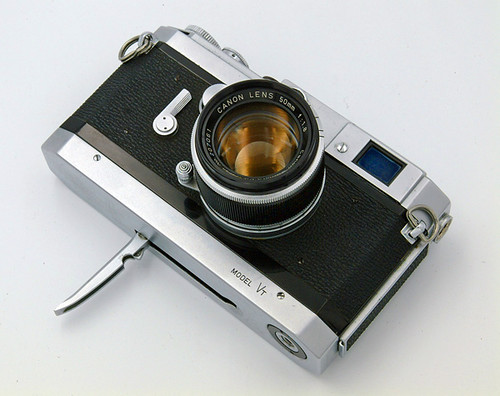Canon VT
The Canon VT is a rangefinder camera released by Canon in 1956. The "V" in the name is the Roman numeral, and the "T" stands for "trigger". Canon had a history of making cameras that modified Leica and (at least since the Canon IIB of 1949) arguably improved on Leica designs,[1] but it was the release of the VT that first made it obvious that Canon could be a leader in 35mm rangefinder design.
Canon kept the Leica screw mount on the VT, but not obviously much else. They changed the film advance from a top-mounted knob to a bottom-mounted trigger advance. The tripod socket was moved to mount a trigger wind grip. They added a swing-open back making the camera easier to load than previous bottom-loading Canons. However, much under the surface was taken from the Canon IVSB2.[2]
The VT uses a cloth shutter curtain, and shutter speeds, selected via the traditional pair of dials, run from 1s to 1/1000th, plus T and B. Flash sync is available for FP, M, and X.
One of the best features of the VT is the improved three-position viewfinder with rotating prisms, which can be set to 35mm, 50mm and RF, the last of these showing only the central area. The viewfinder still lacks parallax correction. However, the RF setting is intended for use in conjunction with a viewfinder mounted in the accessory shoe, with automatic parallax correction.
Canon brought out a 50mm f/1.2 and a 35mm f/1.8 lens at about the same time as this camera.[3] Canon lenses ranged from 25mm to 800mm.[4]
The trigger winder can be awkward to use for rapid shooting either with a longer lens or when the camera is held "vertically" (for "portrait" format).[5]

|
| Canon VT with 50mm f/1.8 lens image by Geoff Harrisson (Image rights) |
Contents
See also
Notes
Bibliography
- Dechert, Peter. Canon Rangefinder Cameras 1933–68. Hove, East Sussex: Hove Foto Books, 1985. ISBN 0-906447-30-5.
Links
- Canon VT de Luxe user manual at Butkus.org
- Cameraquest's Canon VT page
- A Canon VT page in a Leica-history site (archived)
- Canon 50/1.2 lens with discussion of the VT, by Davidde Stella. (Via Wayback, therefore slow. Choice of this particular Wayback image is arbitrary. The original URL is http://www.davidde.com/articles/canon5012.html .)
- Canon VT at Sylvain Halgand's www.collection-appareils.fr (in French)
- Canon VT article & images by Geoff Harrisson
